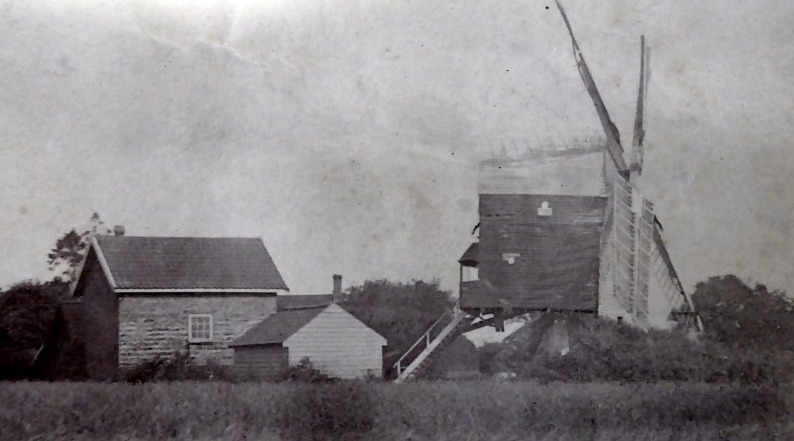The White Mill, Forncett End
The White Mill
The first direct evidence of the White Mill is on the Forncett Enclosure map of 1813 and a related map published in 1817 (see below). Enclosure 105 (0a. 2r. 34p. i.e. about half an acre) was owned by Hry. Knights and is where the Jolly Farmers P.H. now stands. There is also a possible dwelling shown adjacent to the Turnpike. The mill is not shown on Faden's map, which was surveyed between 1790 and 1794, and so it appears that the White Mill was probably built between 1790 and 1813.

A clue as to when the White Mill was first built comes from an engraved section of a mill post now found in the bar of the Jolly Farmers. The engraving is marked "H.K. May 2 1793" suggesting that it could have been executed by a Henry Knights and might record the construction of the mill in May 1793. Immediately below the date is a depiction of a post mill that could be the White Mill and below that is a double-fronted house that looks very similar to the left hand side of the Jolly Farmers seen in a 1910 postcard.



The Henry Knights referred to on the 1813 Enclosure map is almost certainly the same Henry Knights who is listed as a Miller in Forncett End on the 1841 census. Henry was the only child of Jonathan Knights (1752-1800), who ran the post-mill in Carleton Rode, and his wife Phoebe. He was born on 13th October 1787 and so he couldn't have been responsible for building the mill in 1793. Henry Knights married Sophia Brown from Bunwell in 1807, at which time he was already living in Forncett. An advertisement in the Norfolk Chronicle on 6th August and 3rd September 1808 indicates that Henry (age 21) was already running the Mill at that time, although it may have been owned by someone else.

Norfolk Chronicle 27 Aug 1808
The advertisement almost certainly refers to the White Mill. It is described as being on "half an acre of freehold land" which agrees with the size of enclosure 105. There is also mention of a "new built dwelling" suggesting that a miller's cottage - the building shown on the engraved mill post - already existed. This building was later to become part of the Jolly Farmers public house.
We have very few photographs of the White Mill. One is on the postcard of the Jolly Farmers (above), dated about 1917, and the other, taken in 1902, is in the archive of Harry Apling in the Norfolk Record Office.

The mill is said to have had a lean-to porch that was the whole width of the mill, and the mill was turned into the wind with a tailpole (both clearly visible in Apling's photograph). One pair of patent sails and one pair of common sails turning anticlockwise, drove two pairs of 4ft 6ins French burr stones, a flour mill and a dressing machine.
Henry and Sophia Knights had five sons and two daughters, and by 1851 Henry (age 62) had been very successful. The 1851 census records that he was both a miller and a farmer, with a farm of 78 acres on which he employed two men. His son John (age 24) was also a miller.
Henry died in November 1852 and was buried at Bunwell parish church. His executors were apparently charged with the task of selling Henry's estate, including the mill. The initial auction sale was set for Monday 25 July 1853 at 4 o'clock at the Kings Head Inn, in Bunwell. However, it would seem that there were no buyers because further auctions were announced in May 1854, in July 1855 and then again by auction in July 1856.

Henry's son John appears to have continued to run the mill (he is listed as "corn miller" in White's 1854 directory) and in the 1861 census he is both a miller and a beerhouse keeper, so the Jolly Farmers has also been born. John Knights had married a girl called Judith from the village of Letton, south of Dereham, and in due course they had two sons (George Robert and Knight Henry) and two daughters (Agnes Lucretia and Caroline Tabitha).
John Knights
continued to run the White Mill until his death (age 53) in 1879. His son,
George had been apprenticed to the mill (see 1871 census) and he then took over
as the miller, whilst his mother, Judith, ran the inn, as documented in the
1881 census.

Judith Knights died in August 1910 and her son George, who had never married, took over the running of the mill and the pub. Neither his brother, Henry, nor his two sisters, Agnes and Caroline, ever married and all four of them helped to run the Mill and the Jolly Farmers.
The mill finally collapsed and fell over at 3.00 a.m. on Sunday 25th November 1917, after one end of a crosstree gave way and it was not noticed in time to save the mill. Whether it was still actively working up until that time isn't clear.
The two brothers and two sisters then continued to run the pub. George died in 1925, Agnes in 1930, Knight Henry in 1931 (all at the pub) and Caroline died in Fundenhall in 1937.

